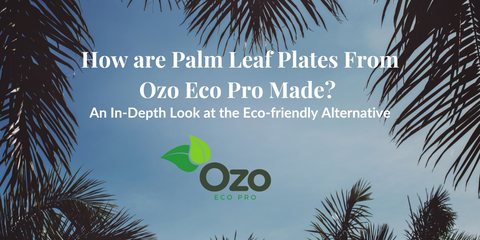How are Palm Leaf Plates From Ozo Eco Pro Made? An In-Depth Look at the Eco-friendly Alternative

As I venture into a more eco-conscious era, sustainable alternatives to everyday items are becoming increasingly popular. One such alternative is the palm leaf plate, a biodegradable, compostable, and highly durable substitute for conventional plastic and paper plates. But how are palm leaf plates made? What are their environmental advantages compared to other materials like bamboo and paper? Let's delve into it, and I hope to share some new insights with you.
The Journey from Tree to Plate: Palm Leaf Plate Production
Palm leaf plates owe their existence to the Areca Palm Tree, predominantly found across Asia. These trees shed their leaves naturally, thus providing a renewable and sustainable resource for plate production.
Collection of Palm Leaves
The process begins with the collection of fallen palm leaves. Unlike other materials that require cutting down trees, palm leaf plates utilize the naturally shed leaves, ensuring no harm to the tree or the ecosystem.
Cleaning and Sanitizing
Once collected, the leaves undergo thorough washing. This step is crucial to remove any dirt, residue, and potential microorganisms present on the leaves.
Shaping and Drying Process
The clean leaves are then subjected to heat and pressure. They're pressed between hot plates molded into the desired shape - round, square, or rectangular. Following the shaping process, the plates are left to dry under the sun, further removing any residual moisture.
Final Sanitization and Packaging
The completely dry plates are sanitized one last time before being packed and shipped. The end result is a sturdy, water-resistant, and heat-resistant plate, capable of handling all types of food.
Comparison of Different Materials: Palm Leaf Plates vs. Bamboo Plates vs. Paper Plates
When it comes to eco-friendly disposable plates, palm leaf plates aren't the only option. Bamboo and paper plates are also commonly used. Let's take a comparative look at these materials.
Palm Leaf Plates from Ozo Eco Pro
As discussed, palm leaf plates are made from naturally shed leaves, ensuring no harm to the environment. They are sturdy, capable of handling hot and cold foods, and are compostable.
Bamboo Plates
Bamboo plates, on the other hand, require the cutting down of bamboo trees for production. Though bamboo is a fast-growing plant, the process isn't entirely eco-friendly. In terms of durability and heat resistance, bamboo plates are similar to palm leaf plates. However, they lack the unique, natural finish of palm leaf plates and often appear more mass-produced.
Paper Plates
Paper plates are lightweight and cheap, but they come with their own share of issues. They're often lined with a thin layer of plastic for water resistance, which makes them non-compostable. Furthermore, the paper industry contributes significantly to deforestation.
Water Resistance and Durability: A Closer Look
Let's take a closer look at the remarkable water resistance and durability of palm leaf plates.
Picture this: you're hosting an outdoor event, and a sudden rain shower surprises you. While traditional paper plates might turn into a mushy mess, palm leaf plates stand strong.
Palm leaf plates are naturally water-resistant, so they can handle moisture without falling apart. Plus, they're durable enough to support hefty portions without breaking. This makes them ideal for outdoor gatherings, no matter the weather.
Palm Leaf Plates
Palm leaf plates can handle hot, cold, wet, dry, and even greasy food. They're sturdy enough to be reused multiple times before composting. When it comes to water resistance, they're natural winners, thanks to the leaf's inherent resistance to moisture.
Bamboo and Paper Plates
Bamboo plates also offer good water resistance, but not as much as palm leaf plates. Paper plates, though water-resistant, owe this trait to a plastic coating, which makes them non-biodegradable.
Energy and Resource Consumption
First, let's talk about paper plates. It's no secret that the production of paper plates is a resource-intensive process. Trees are cut down in vast quantities to manufacture paper, contributing to deforestation and habitat loss. Not only does this consume a significant amount of natural resources, but it also requires energy and chemicals to convert wood pulp into paper plates. The environmental toll is undeniable, and it's time we take a hard look at our choices.
Now, bamboo plates, although often considered a more sustainable option compared to paper, still come with their set of challenges. Bamboo requires substantial water and energy for its growth, and the processing of bamboo into tableware can involve the use of chemicals, which have their own ecological impact. So, while bamboo plates might seem like a greener choice, they're not as eco-friendly as they might appear.
Here's where palm leaf plates step in as the environmental superheroes. These plates are produced with minimal resource consumption. No trees are harmed, and no chemicals are used in their creation. The palm leaves used for these plates are a natural byproduct of the Areca palm tree, which is abundant in many parts of the world. It's a renewable resource that doesn't require additional planting or extensive irrigation.
What's more, the energy needed to transform palm leaves into plates is remarkably low compared to bamboo and paper plate production. This means a reduced carbon footprint and a more sustainable option for our planet. Palm leaf plates prove that it's possible to have convenient, disposable tableware without harming the environment.

Microplastics and Pollution
You know, it's incredible how small things can sometimes have a big impact on our planet. Take microplastics, for instance. They're those tiny, nearly invisible plastic particles that are all around us, and they're causing quite a stir in the environmental world. But don't worry, there are ways to tackle this issue, and it starts with what we use every day.
Think about the plates you use at picnics or barbecues. You've probably used plastic or coated paper plates, right? Well, those seemingly harmless plates can be a big contributor to microplastics pollution. These plates can break down into tiny plastic particles, which find their way into our environment, waterways, and eventually, even our bodies. Yikes!
But here's where the good news comes in. There's a fantastic alternative – palm leaf plates. These plates don't add to the microplastics problem at all. In fact, they're like nature's gift to eco-conscious people like myself. When you're done with your meal on a palm leaf plate, you don't have to worry about it contributing to pollution. Why? Because they decompose naturally, leaving no harmful residues.
Environmental Benefits of Palm Leaf Plates
Palm leaf plates offer numerous environmental benefits:
- Sustainable Resource Utilization: They utilize naturally fallen leaves, ensuring no harm to trees.
- Biodegradability: They decompose naturally in a relatively short time, reducing landfill waste.
- No Chemicals: Their production process involves no chemicals, thus preventing chemical pollution.
- Reduced Carbon Footprint: Their production process consumes less energy, which means less carbon emissions.
How Do You Dispose of Palm Leaf Plates?
Let's explore the eco-friendly way to dispose of palm leaf plates. It's a breeze, and it's all about keeping our environment in mind.
When you're done enjoying a delicious meal on your palm leaf plates, the disposal process couldn't be simpler. Unlike many disposable options, palm leaf plates are kind to the planet from the very beginning.
To dispose of palm leaf plates, you can just toss them into your compost bin. That's it! No need to worry about special recycling facilities or complex disposal methods. These plates are made from natural materials, and they'll naturally decompose within just 6-8 weeks. As they break down, they'll enrich your compost with valuable organic matter, making it even better for your garden.
The beauty of this disposal method is that you're closing the loop in a sustainable way. You're not adding to landfills or contributing to pollution. Instead, you're giving your palm leaf plates a second life as a valuable addition to your compost, which, in turn, supports the growth of more plants and vegetables.
So, the next time you're finished with your palm leaf plates, remember to dispose of them in your compost bin. It's a small but meaningful step towards a more environmentally friendly and sustainable lifestyle. By choosing palm leaf plates and composting them, you're making a real difference in reducing waste and nourishing the Earth.
Conclusion
In conclusion, palm leaf plates are a sustainable, eco-friendly alternative to traditional disposable plates. Their production process is environmentally friendly, and they offer all the functionality of regular plates without the negative environmental impact. So next time you're planning an event, consider choosing palm leaf plates and contribute to a greener planet.
References
You Might Also Like
- https://www.chicleaf.com/blogs/news/palm-leaf-plates-vs-bamboo-plates#:~:text=Whether%20you're%20going%20to,beautiful%20on%20any%20table%20setting.
- https://www.greenhive.io/blog/eco-friendly-disposable-palm-leaf-plates#:~:text=Palm%20Leaf%20Plates%20are%20an,are%20also%20biodegradable%20and%20compostable.
Recommended Products:












